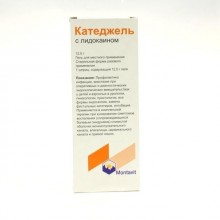



Cathejell - combined preparation for topical use in urology.
Lidocaine hydrochloride has a local anesthetic effect. With a high dose and long-term use on the mucous membrane, the concentration of lidocaine in the blood plasma is 1-2 μg / ml. When symptoms of severe inflammation of the mucous membrane of the urethra, it is necessary to take into account the increase in lidocaine resorption.
Chlorhexidine has antimicrobial activity against many gram-negative bacteria, but does not affect acid-resistant bacteria, spores, fungi, and viruses. In this concentration, chlorhexidine helps to prevent the development of an ascending infection of the urethra and bladder.
For instillation into the urethra before inserting a catheter or other instruments.
1 g of gel for topical use contains:
No customer reviews for the moment.
For slow instillation into the urethra, before insertion of instruments (by a doctor or specially trained personnel), it is necessary to:
To facilitate the introduction, it is recommended to pre-squeeze a drop of the drug.
Instillation should be carried out by light pressure on the corrugated syringe. After emptying the syringe, it is necessary to keep it in a compressed state until it is removed from the canal.
The insertion of the instruments is recommended 10 minutes after gel instillation.
Allergic reactions.
Data on drug drug interactions Lidocaine cathedles not provided.
May be used during pregnancy and lactation (breastfeeding).
For severe bradycardia, during anesthesia, it is recommended to use lubricants that do not contain lidocaine.
In the case of the “false path” do not enter into the urethra (it is possible to apply the gel on the instrument or suprapubic urinary diversion).
Data on drug overdose Lidocaine cathedles not provided.